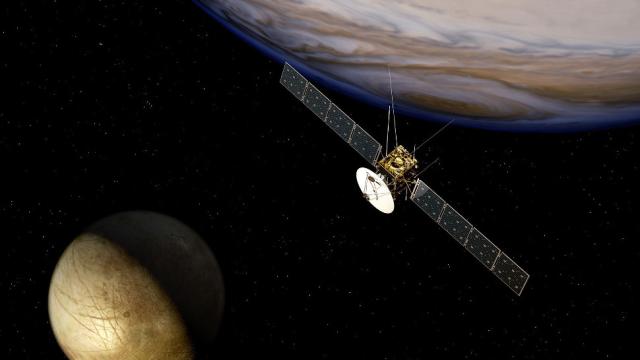They say the shortest distance between two points is a straight line, but for JUICE — a European Space Agency-led, Jupiter-bound probe scheduled to launch in 2022 — the quickest route will involve a rather convoluted journey requiring four gravitational assists with three different planets.
Artist’s impression of JUICE. (Image: ESA)
Announced back in 2012, the Jupiter Icy Moons Explorer, or JUICE, is set to launch in June 2022 from Kourou in French Guiana. The spacecraft will arrive at Jupiter after a seven year journey, where for 3.5 years its 10 state-of-the-art instruments will explore the gas giant’s turbulent atmosphere, enormous magnetosphere, its nearly-invisible rings, and its satellites. At the end of the mission, JUICE will enter into the orbit of Ganymede, and become the first spacecraft to orbit a natural satellite other than the Earth’s moon.
JUICE represents Europe’s first mission to Jupiter, or any of the Solar System’s outer planets for that matter. Currently, NASA’s Juno space probe is orbiting Jupiter, but it’s focusing exclusively on the gas giant, scanning the planet’s composition, gravity field, magnetic field, and magnetosophere. JUICE will also study Jupiter’s atmosphere, but it’s also going to take a look at its icy moons — Ganymede, Europa and Callisto. These moons are thought to harbour subsurface oceans — and possibly even habitable environments.
But before any of this pioneering exploration work can happen, JUICE is going to have to make a series of tricky manoeuvres to get there.
Remarkably, JUICE’s journey will involve three planets and four gravitational assists — including two from Earth. The video above shows the journey, where the orbit of Venus is shown in yellow, Earth in green, and Mars in red. Here’s the probe’s cosmic itinerary courtesy the ESA:
- The first Earth flyby will be at a distance of 12,700km in May 2023
- JUICE will fly past Venus at a distance of 9500km in October 2023
- The next Earth flyby will be the closest, at 1950km in September 2024
- JUICE will fly past Mars at a distance of 1100km in February 2025
- The final flyby will be 3700km from Earth in November 2026
Once JUICE arrives at the Jovian system (in October 2029), it will have to perform even more gravitational assists, but these moon-to-moon assists (as many as 25!), involving Ganymede and Callisto, are designed to slow down and orient the orbiter.
[ESA]
